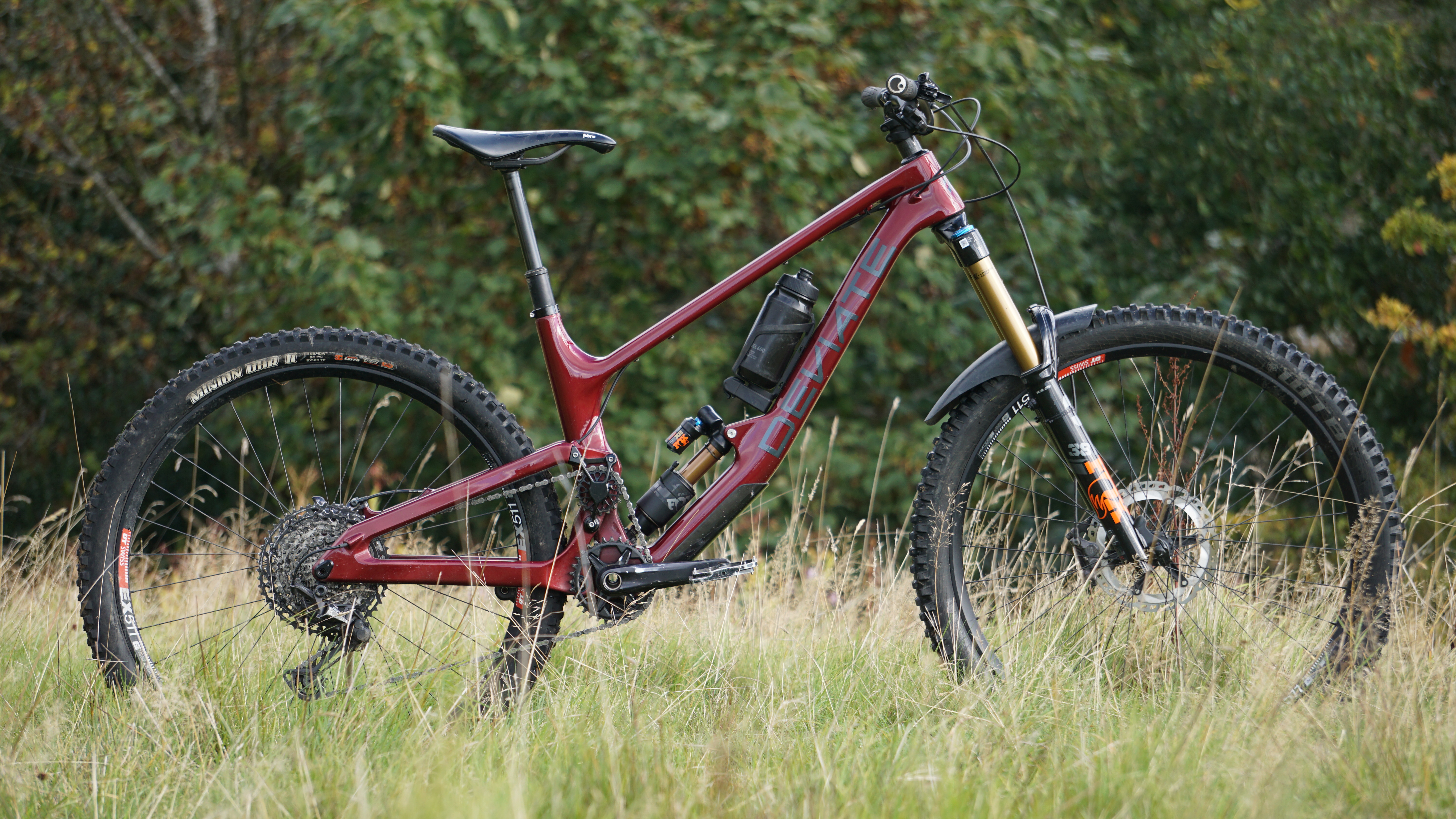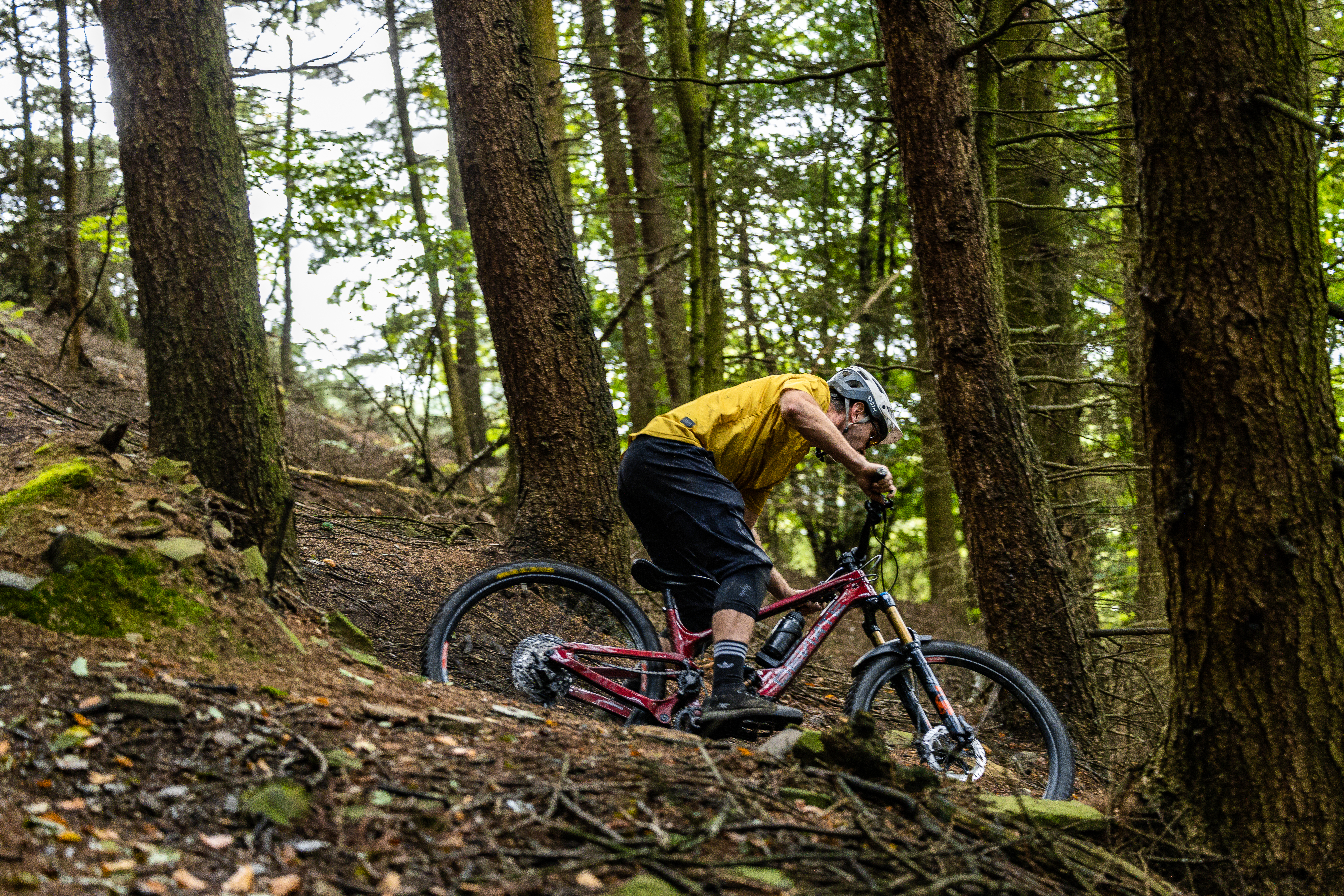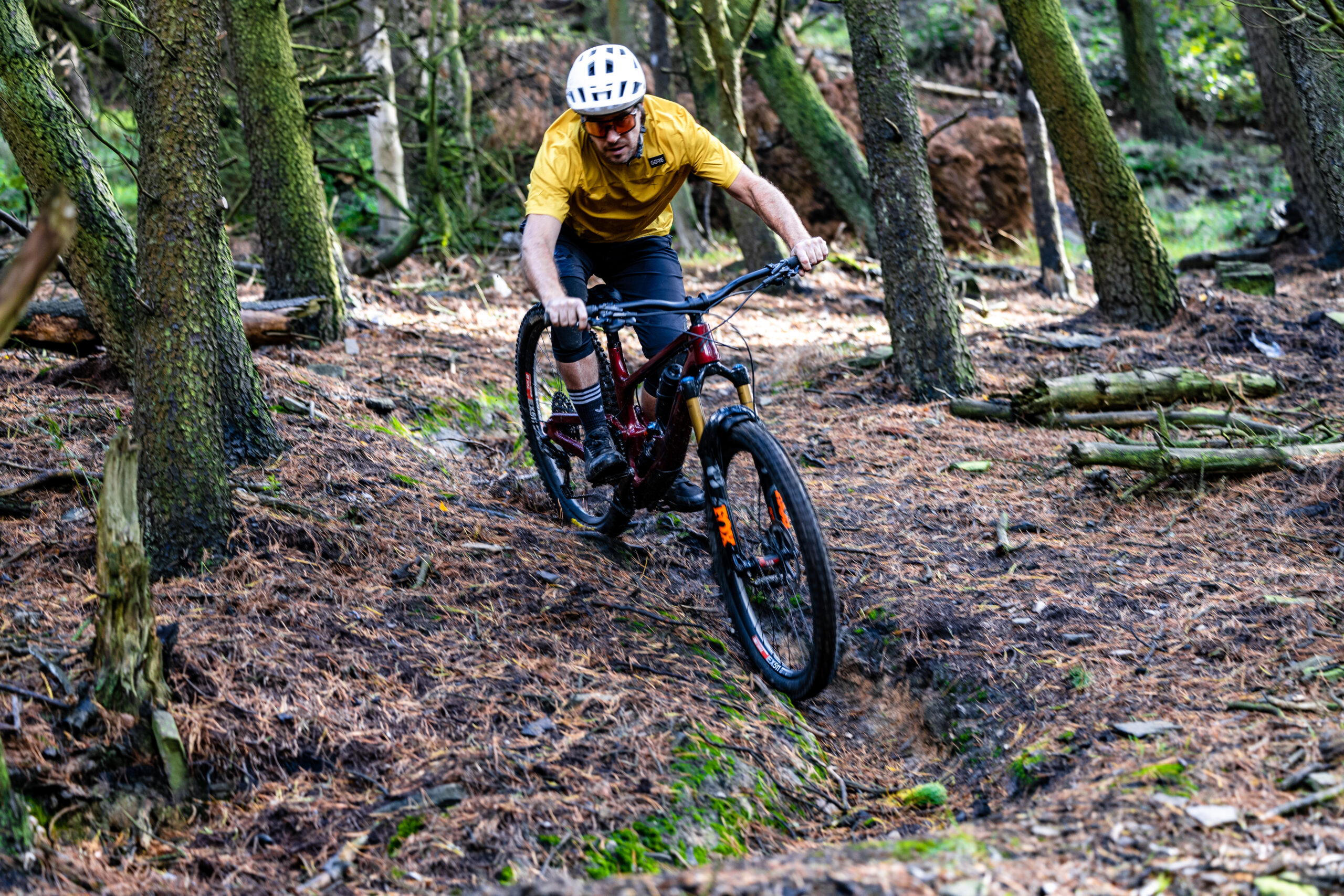The Deviate Claymore is the first long travel enduro bike from the Scottish brand. Named after a historic Scottish two-handed sword ⚔️
- Brand: Deviate
- Product: Claymore
- Price: £3,939 frame inc. shock
- From: Deviate Cycles
- Review by: Ross for 2 months
This product was selected for our Editors’ Choice Awards 2022, as published in Singletrack Magazine Issue 146

Ross: “I’m lucky enough to get to ride quite a few different bikes throughout the year, and the Claymore is the one that I’d happily keep in the shed. While it looks like a long-travel, very race-focused bike on paper, it’s more versatile than the numbers on the geo sheet allude to. It climbs well and will get you up anything your legs can manage. It is happy enough to be pedalled and ridden as a trail bike, rather than just enduro-ed steep up, steep down. But, open the taps and it does show its harder hitting DNA. That high pivot suspension isn’t just hype. The Claymore hoovers up big hits, small hits, rooty tracks, rocky tracks… basically whatever you point it at. Get off the brakes and let it run and it’s an amazing experience. Good geo, good looks, good suspension. The Claymore’s got it all.”


Original Review:
The Claymore is designed to go fast on the biggest, steepest trails you can find, whether that’s on the big, chunky, rocky trails of the Scottish Highlands, or pinning it down an EWS race track. The Claymore is made to take it all in its stride.
Utilising Deviate’s high pivot suspension design, the Clymore delivers 165mm of rear wheel travel and is paired with a 170mm fork up front. While that puts it formly in enduro bike territory, Deviate wanted to make a bike that was not purely focused on racing. A bike that could get between the tape one day, and head out for a trail ride with mates the day after.

Frame
At the heart of the Claymore is a full carbon frame. In the name of all-weather-riding (as you’d expect from a Scottish brand), the Claymore features grease ports on all pivot and idler bearings and twin lip wiper seals to help keep the worst of the weather out and things running smoothly.
All pivots also run on Enduro bearings and the 18 tooth idler runs on twin outboard sealed bearings.
Cables are routed along a ‘cable gutter’ on the underside of the toptube, rather than through the front triangle, which keeps things neat and helps with maintenance, although they do then head through the rear triangle.


While it uses a high pivot, the Claymore still uses a standard 126 link chain for ease of replacement and installation. Inside the front triangle you’ll find mounts for not only a bottle cage (a full size bottle fits), but also accessory mounts, so while it might not feature the current de-rigeur internal frame storage, you can carry all the essentials you need.
On the downtube you’ll find a bolt on carbon frame protector to ward off rock strikes, and on the chainstay is a moulded and bonded rubber protector. The back end is 148 Boost spaced with room for a 2.6in tyre and the BB is a proper threaded one.
Geometry
As you’d expect from a longer travel enduro bike, the Claymore’s geo has had a good dose of the long, low and slack treatment. Headline numbers for our size large test bike are a 490mm reach, 64.3° head angle, 78° seat angle and 441mm chainstays.
Seat post lengths have been kept nice and short to allow for long droppers, and for sizing up, while ETT lengths are reasonably compact due to the steep seat angles. Our size L had a stack of 630mm making it easy to get the bars to our preferred height.
Suspension
As with all other Deviate bikes, the Claymore uses a high single pivot suspension layout. The nature of a high pivot design means there is a rearward axle path throughout the majority of the travel, helping get the back end out of the way, and adding stability.

The position of the idler plays a part in the suspension tuning and the Claymore’s has been positioned to reduce pedal kickback and let them tune the anti-squat for better pedalling characteristics.
The linkage is designed to offer a very progressive leverage curve for hard charging while remaining supple in the initial part of the stroke, while the anti-rise allows the suspension to compress slightly under braking, which results in “a more stable geometry, because there is a reduced weight transfer to the front wheel.”
Build kit
The Claymore is currently only available as a frame only option, but our test bike was built with the sort of build I can imagine plenty of bikes will be in the ‘real world’. Although you can ‘spec’ a bike on the Deviate website and one of their dealer network will get in touch with a quote which is a cool feature.



The frame retails for £3,300 plus shock, and Deviate offers shocks from Fox, Cane Creek and Öhlins. Our bike came spec’d with a Fox Float X2 Factory air shock which offers separate high and low speed compression and rebound adjustment, along with a 2 position platform. This is matched with a Fox 38 Factory up front, which again offers individual high and low speed compression damping.
Stop and go are both taken care of by Shimano, with a full 12 speed XT drivetrain paired with a set of powerful XT 4 pot brakes. Up front is a 203mm Ice Tech rotor with a 180mm out back.



The DT wheels came shod with a DHRII on the rear and a Assegai on the front, both in EXO 3C MaxxTerra casing. I did swap the front tyre part way through the test to a WTB Vigilante Wet for a bit more bite as the trail conditions changed.



The cockpit was taken care of by OneUp Components with a 35mm rise carbon bar, held in place with a nice and short 35mm OneUp stem. As was the dropper post with a OneUp TwoTen mated to a Shimano lever. Rounding out the components was a Fabric scoop saddle and a set of Ergon grips.
All this adds up to an overall weight of 16.1kg – with a smattering of local mud and bottle cage!
Setting up
Given that Fox has plenty of info and tuning guides online, getting the suspension set up on the Claymore was pretty straightforward. I set the sag with my preferred 30% on the rear and 20% on the front, which equated to 190 psi in the shock and 90 psi in the fork for my 86kg weight.
Compression and rebound settings were set using Fox’s recommendations. After an initial set up ride to get things dialled in, that included repeated runs on tracks that had everything from fast turns, to rocks, to roots, I settled on the following settings (all from fully closed):
Shock:
- LSR – 13 clicks
- LSC – 8 clicks
- HSR – 3 clicks
- HSC – 6 clicks
Fork:
- LSR -10 clicks
- LSC – 10 clicks
- HSR – 2 clicks
- HSC – 8 clicks
Climbing
Given the up-to-date geo numbers on the Claymore, it’s a familiar and easy place to jump aboard and spin away. The steep seat angle puts you in a great position, with your hips over the BB, making it comfortable for long stints in the saddle.
For a bike with a 165mm travel the Deviate Claymore does climb well. It’ll not break any records, but it’s certainly no slouch or burden when it comes to going up. The suspension does a good job of firming up when under load so it doesn’t bob and sag when climbing, but still remains supple enough to smooth out lumps and add grip.
The geo lets you stay seated and centred, and point it up something steep and tech and the Claymore will keep going as long as your legs do. It might not be XC quick going up, but it climbs better than you might first think
Descending
While the Deviate Claymore might be a decent climber, point the trail in the other direction and it’s properly good. It might have a good amount of travel, coupled with a high pivot suspension system, but it’s way more than just a point and shoot plough machine.
Given its enduro intentions, it’s still fun and engaging to ride on mellower, flowier terrain where some longer travel bikes feel sluggish and unreactive. Even with the slack-ish head angle and decent wheelbase it still feels lively and responsive, and though the rear end doesn’t feel hugely progressive through the middle of the travel, there’s more than enough support for pumping the trail and jumping off things

When it gets rougher the rear end does an amazing job of soaking up anything from small, to big, to repeated hits. The rearward axle path helps to get things out of the way and hitting rough sections at full gas in the middle of the travel, is addictive. There’s a controlled, buttery feeling to the rear end which also adds Grip across off-cambers and roots and allows you to pick a line and go with it without worrying.
On properly steep trails the geo works to keep you centred on the bike, and you can drop your heels to really push the rear end in, searching for grip, while still weighting the front. The rear centre may grow under compression but the Deviate Claymore still loves turns, and I never had any issues, whether that was a slappy, muddy rut or a high speed berm, the neutral handling just feels right.



Overall
⚔️ ⚔️ ⚔️ ⚔️ ⚔️ ⚔️ ⚔️ ⚔️ ⚔️ ⚔️
On paper the Deviate Claymore looks like a big bruiser of a bike, but it’s way more versatile than the geo sheet would suggest, and is an easy bike to live with on a day to day basis. It’s happy to spin along and do a ‘trail’ ride but really shines when you open it up.
I guess the true measure is: would I want to own one? And the answer to that is… a definite yes.
⚔️ ⚔️ ⚔️ ⚔️ ⚔️ ⚔️ ⚔️ ⚔️ ⚔️ ⚔️
Specification
- Frame // Full Carbon, 165mm
- Shock // Fox Float X2 Factory 2Pos
- Size Tested // L
- Sizes Available // M, L, XL
- Weight // 16.1kg
Geometry of our size L test bike
- Head angle // 64.3°
- Effective seat angle // 78°
- Seat tube length // 430mm
- Head tube length // 108mm
- Chainstay // 441mm
- Wheelbase // 1,268mm
- Effective top tube // 622mm
- BB height // 30mm BB drop
- Reach // 490mm
Join our mailing list to receive Singletrack editorial wisdom directly in your inbox.
Each newsletter is headed up by an exclusive editorial from our team and includes stories and news you don’t want to miss.







